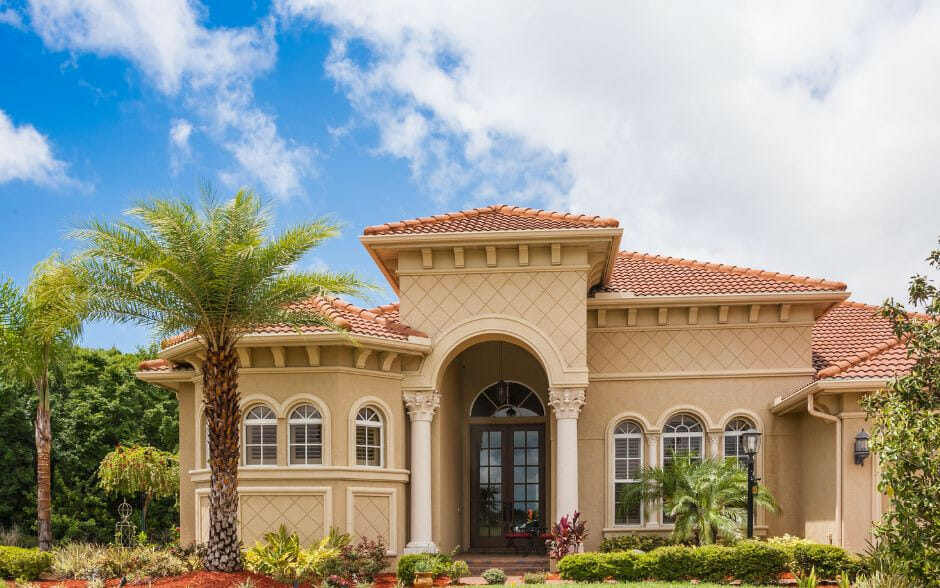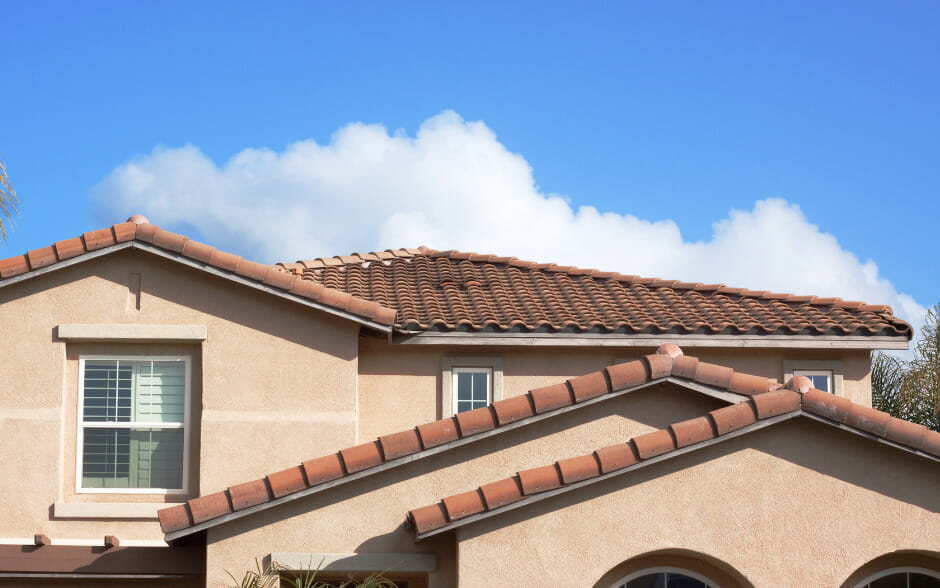If you’re looking for a unique roofing option, traditional shingle roofs may not provide the extraordinary style you desire. While shingle roofs are functional and visually appealing, they don’t quite match the beauty of tile roofs. In this article, we’ll discuss nine types of roof tiles, their advantages, and the benefits that distinguish them from each other.
A Brief History of Roof Tiles
Roof tiles are primarily designed to protect a home from water damage. They differ from asphalt shingle roofs in terms of material composition and appearance. Slate tile roofs date back to the 1600s, and clay roofs can be traced as far back as 10,000 BC. Slate and clay were popular choices due to their local availability, but the 19th century saw the emergence of concrete and metal tiles.
9 Types of Roof Tiles: Exploring Materials and Benefits

Roof tiles offer a fantastic way to personalize a home, but they differ in cost, durability, weight, and appearance. Below, we’ll explore the nine most popular roof tile types and what sets each material apart:
Slate Roof Tiles
Slate is a natural stone that offers a unique and stunning appearance, with dramatic color variations created by time and nature. It’s fire-resistant, durable, and long-lasting, making it a sophisticated roofing material. However, slate is incredibly heavy and requires structural reinforcement to support the additional weight. It’s also expensive to install and challenging to handle, which can complicate repairs.
Metal Roof Tiles
Copper, aluminum, zinc, and steel are common materials for metal roof tiles, with steel and aluminum being the most popular. Metal tiles come in various patterns and shapes, imitating products such as barrel tiles (Spanish roofs), slate tiles, wood shake tiles, and regular shingle patterns. Metal roof tiles have gained popularity due to their lightweight nature and ease of installation. However, their benefits can also be disadvantages:
Metal can be noisy
Metal dents easily, making repairs difficult
Wet metal surfaces are dangerous to walk on
Metal conducts temperature and offers little insulation value
Concrete Roof Tiles
Concrete roof tiles emerged in 19th-century Bavaria, as the basic components were affordable and readily available. Initially handmade, modern production methods have made concrete roof tiles one of the most economical options. They’re designed to resemble wood shakes, clay tiles, and slate tiles and are visually appealing. However, concrete is heavy and requires reinforced roofing structures to handle the added weight. Proper installation and maintenance necessitate roofing crews experienced with concrete roof tiles.
Composite Roof Tiles
Composite slate roof tiles are made from a blend of natural and man-made materials, offering numerous advantages over natural stone, wood, clay, metal, or concrete tiles. They can mimic the appearance of various tile roofing products while providing custom color mixes for most patterns. Composite tiles are lighter, come with excellent warranties, and can typically be installed by experienced roofing contractors.
Solar Roof Tiles
Solar roof tiles replace traditional roofing materials with electricity-generating tiles that connect to a battery assembly inside your home, drawing power naturally from the sun. If enough tiles are installed, a solar roof can significantly reduce your electric bill. While there are a few different styles available, most people prioritize performance over appearance. Solar roof tiles are more expensive and require specialty professionals for installation, maintenance, and repair. For environmentally conscious consumers, solar tiles are a step towards greener construction materials and practices.
Clay Roof Tiles
Clay roof tiles have a long history because their base material is easily accessible. Initially shaped by hand and sun-dried, modern production methods have streamlined the process, but the final product remains just as beautiful. Most clay roofs are available as barrel or flat tiles, with a variety of colors and water-resistant sealants. Clay tiles are extremely heavy, prone to breaking if mishandled, and require installers with extensive experience. Like concrete and slate, a roof with clay tiles needs significant reinforcement to support the extra weight.
Synthetic Spanish Barrel Roof Tiles
Synthetic Spanish Barrel roof tiles offer the timeless elegance of a Spanish Villa without the extra cost of reinforcing your entire roof. These tiles are recyclable, fire-resistant, and available in a wide range of color combinations. They also don’t require the maintenance that clay roof tiles demand.
Synthetic Slate Roof Tiles
Synthetic or composite slate roof tiles resemble authentic slate without the weight and hassle of replacing broken tiles or regularly maintaining gutters. These tiles have a Class 4 impact rating and can be designed with unlimited color options. They are lightweight and made from eco-friendly composite materials.
Synthetic Cedar Roof Tiles
Synthetic Cedar Roof Tiles are an excellent alternative to real cedar shakes. Made from a composite material, they won’t warp, crack, split, or rot and don’t attract fungus like real cedar shakes. These lightweight and easy-to-install shingles give the appearance of a cedar split shake roof without the associated problems. Brava’s cedar shake tile comes with a Class A or Class C fire rating and a Class 4 impact rating, ensuring a beautiful and long-lasting roof with a wide variety of color options.
Why Roof Tiles Surpass Shingle Roofs?
Shingle roofs protect your home from water damage and add color, but roof tiles offer an unparalleled variety of options not available with asphalt shingles.
Choosing the Best Roof Tiles for Your Home

We’ve discussed concrete tiles, composite roof tiles, and ceramic tiles compared to shingle roofs. As you explore tile options, you’ll encounter other roofing materials, like interlocking roof tiles, barrel tiles, square clay tiles, polymer sand, and Portland cement. Fortunately, you don’t need to become an expert on roof structures, pitch, or tile choices. Our team of skilled roofers can help you select the best roofing tiles for your home, assessing your needs and preferences alongside various roof tile choices and costs per square foot to determine the optimal solution.
Tile Roofing in the US: Popular Regions
Concrete tile roofs are prevalent throughout the Sunbelt region, which includes states like Alabama, Arizona, Arkansas, California, Florida, Georgia, Louisiana, Mississippi, Nevada, New Mexico, North Carolina, Oklahoma, South Carolina, Tennessee, and Texas. They are also immensely popular in California and Florida.
Cold Weather Compatibility of Tile Roofs
Concrete roofing tiles aren’t ideal for areas with rapid freeze-thaw cycles and extreme winters, especially at higher elevations. However, specialized concrete roofing products are available for cold climate use. Thanks to technological innovation, many manufacturers have introduced exceptional concrete tile products for customers in colder regions. These products offer elegance, aesthetic appeal, and additional benefits when installed in colder areas.
Tile Roofing Cost and Quality Considerations
When it comes to tile roofing, you get what you pay for. Cheaper alternatives may lack the beauty and design of more expensive roof tiles and may be of lower quality, requiring more frequent replacements. Choose a trustworthy roofing contractor to help you select quality materials and avoid early roof tile repairs. For a general idea of tile roof repair and installation costs, you can use online cost calculators. However, we recommend relying on a roof tile expert to determine the actual project scope and final costs. They will know what’s best for your property and provide suitable options for your project.
Division Kangaroof: Style Meets Durability in Roof Tiles
At Division Kangaroof, we install composite roof tiles to meet your style and taste expectations without compromising quality. We only install roof tiles manufactured by industry-leading companies that offer warranty to make sure that your roof is built to last. Remember, durability is more than just a buzzword; it signifies that the roof tiles will stand the test of time. Our roof tiles are designed with your satisfaction in mind.
In conclusion, various types of roof tiles offer unique benefits in terms of aesthetics, durability, and cost. To make the best decision for your home, consult with experienced roofing professionals who can guide you through the process and help you choose the right materials for your needs. Roof tiles not only protect your home but also enhance its beauty and value, making it essential to invest in high-quality products that will stand the test of time.


